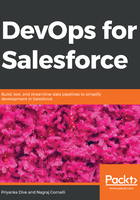
What this book covers
Chapter 1, Salesforce Development and Delivery Process, gives an overview of the traditional Salesforce development process, including the environments used and how to set up an environment with Eclipse and Force.com IDE. We will also discuss sandboxes and types of sandbox.
Chapter 2, Applying DevOps to Salesforce Applications, discusses the need for DevOps in Salesforce projects and what challenges we might face while handling the development and deployment of large Salesforce projects.
Chapter 3, Deployment in Salesforce, shows how to deploy Salesforce code from one sandbox to another sandbox, from one sandbox to production, and from one organization to another organization. We will learn about the different types of code deployment and how to use them depending on the type of project.
Chapter 4, Introduction to the Force.com Migration Tool, discusses the Force.com Migration Tool and how to set up the tool in your environment. We will also see a sample deployment of metadata to a developer or test sandbox using the Ant Migration Tool.
Chapter 5, Version Control, helps you to understand source code versioning systems and their types. We will mainly focus on distributed Git version control. We will also learn about using Git with Salesforce projects and saving Salesforce metadata to Git.
Chapter 6, Continuous Integration, shows how to automate backups for Salesforce metadata and push code to the Git repository using Jenkins. We will also learn how to set up our own Jenkins server and configure it to retrieve metadata from our Salesforce sandbox.
Chapter 7, Continuous Testing, talks about code quality and continuous testing. We will discuss the tools used in automation testing, such as Selenium and Qualitia. We will also look at a test case in a sample Salesforce application using record and playback in Selenium.
Chapter 8, Tracking Application Changes and the ROI of Applying DevOps to Salesforce, discusses the basics of Bugzilla and how to track issues when they are reported by a tester or user. We will also learn how to enhance productivity and measure ROI.